Cartagena is Colombia’s most visited city for a reason, thanks to its colonial architecture, stunning beaches, and diverse mix of traditions. There’s no shortage of things to do within the city limits, but located on Colombia’s Caribbean coastline, Cartagena is also a great jumping-off point for a number of unique day trips.
Whether you’re looking for powdery white beaches or towns full of history, there’s plenty to be found just a short drive from Cartagena’s historic city walls. Located in the heart of the región de la costa, getting outside the city of Cartagena is a great way to learn about the diversity of cultures in the Colombian Caribbean.
So history lovers and outdoor adventurers alike, grab your sunscreen and let’s get exploring! Here are the best day trips from Cartagena so you can truly make the most of your trip.
Have safety concerns about visiting Colombia? Check out my in-depth guide to safely traveling in the country!
This site uses affiliate links to share products that I use and love! If you click on one of the links I may receive a small commission at no additional cost to you. This helps keep my site up and running — thank you!
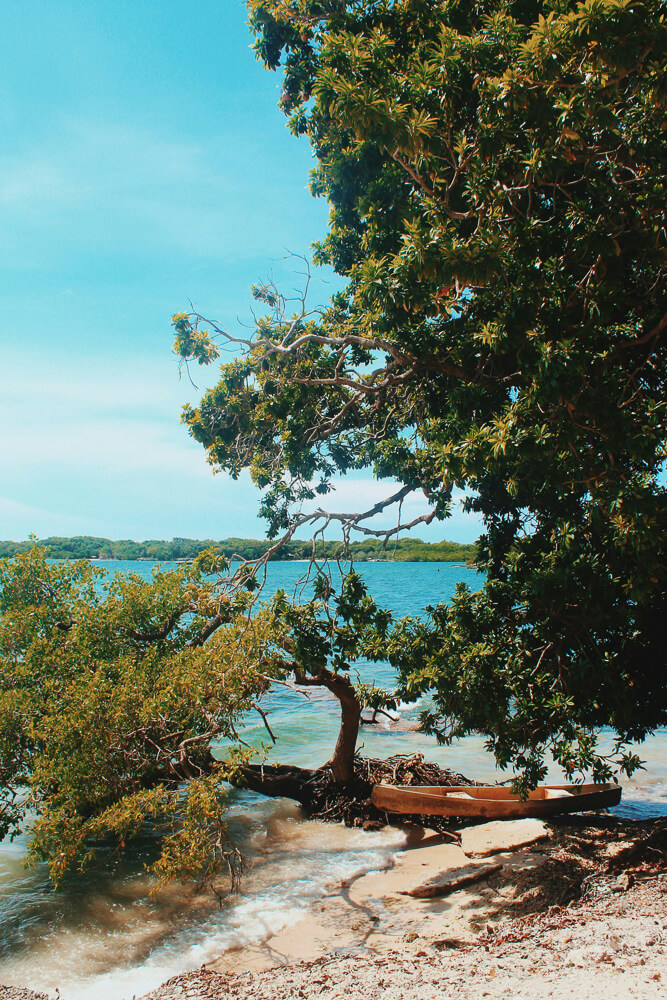
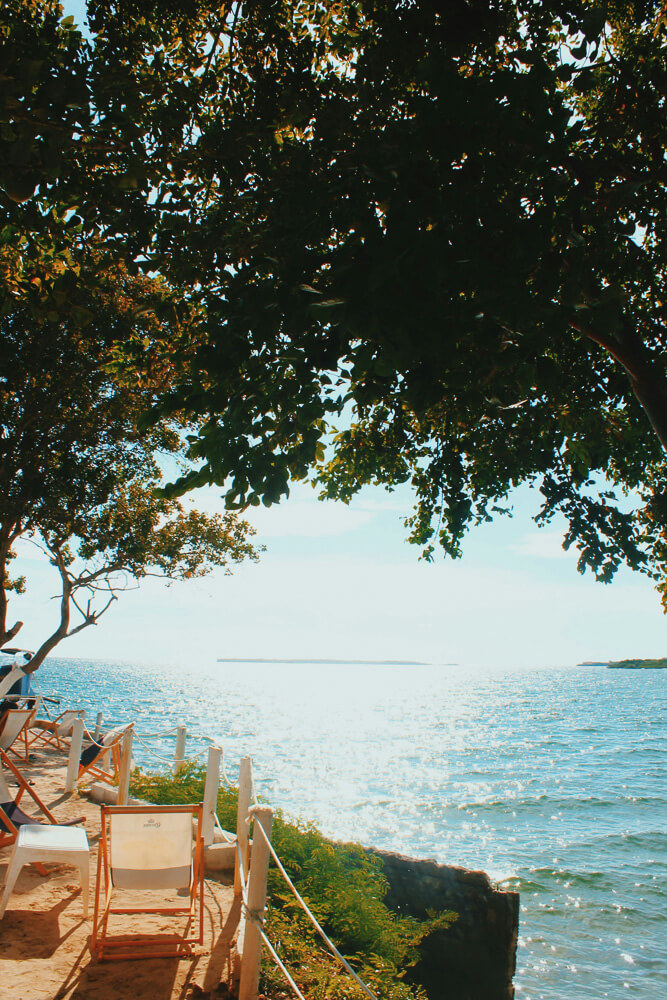
Colombia Quick Links
✈️ Flights – Use Kiwi.com or WayAway to find the cheapest and fastest flights to Colombia
🛏️ Accommodation – Find the best places to stay throughout Colombia on Booking.com
✅ Get Insured – I personally use Safety Wing Nomad Insurance for my travels all around the world! VisitorsCoverage is another great option.
🚗 Rent a Car – Find the best deals for a Georgia road trip on RentalCars.com
🗺️ Find Things to Do – Check out Get Your Guide or Viator for exciting adventures all around Georgia
☎ Buy a Sim – Airalo offers eSIMS for over 200 countries and regions
Looking to spend more time in Colombia? Check out my full 3-week itinerary!
The 10 Best Day Trips from Cartagena
Whether you’re looking to learn more about the history and culture of the coast or just lounge the day away on one of Cartagena’s best beaches, here are the top 10 best day trips from Cartagena, Colombia. Check out the map below to help plan your trip!
WATCH: The Ultimate Guide to Cartagena (and beyond!) – BOLÍVAR 5/32
1. Snorkel with Bioluminescent Plankton at Playa Blanca
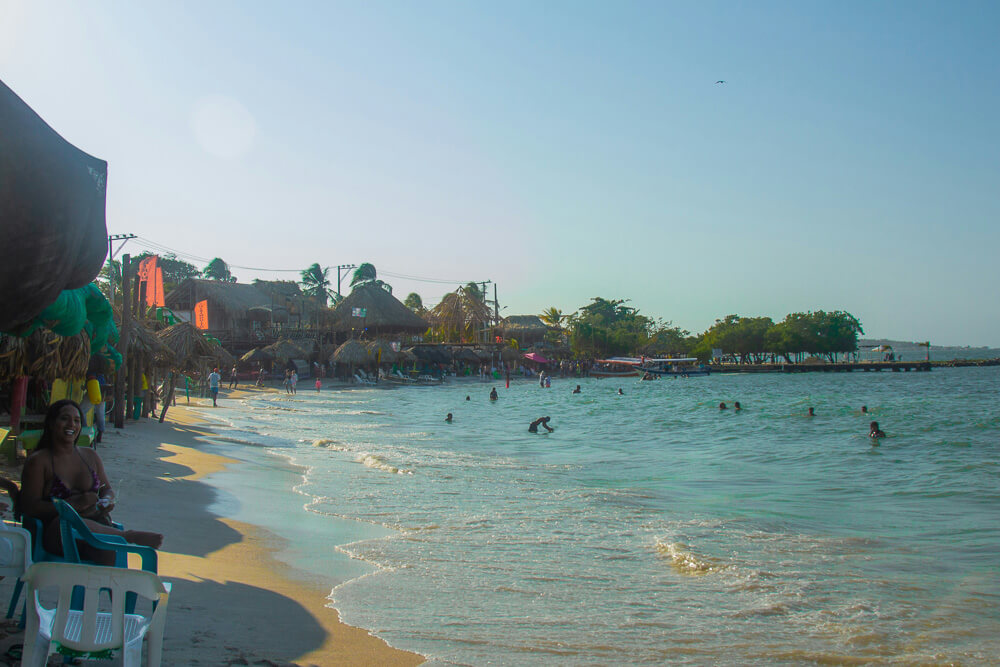
Perhaps the most quintessential of Cartagena’s beaches, the powdery-white sand and crystal-clear water of Playa Blanca are located in the heart of Isla Barú – a peninsula located just 45 minutes from downtown Cartagena. If you’re dreaming of the perfect beach vacation, look no further!
Playa Blanca is home to a number of beach clubs and restaurants, so it’s the perfect spot to spend a day under the sun. However, once the sun goes down the real magic happens, as bioluminescent plankton sparkle in the lagoons surrounding the beach. Join a bioluminescent plankton tour to discover the very best spots – you’ll feel like you’re swimming among the stars!
Playa Blanca can be visited both independently or on a tour. You can hop on the Playa Blanca shuttle (cost: 50,000 COP or ~$13) outside of Hostel Mamallena, which leaves twice daily. Don’t want to DIY? Check out this full-day tour which includes a nighttime swim with bioluminescent plankton.
2. Learn to scuba dive at the Rosario Islands
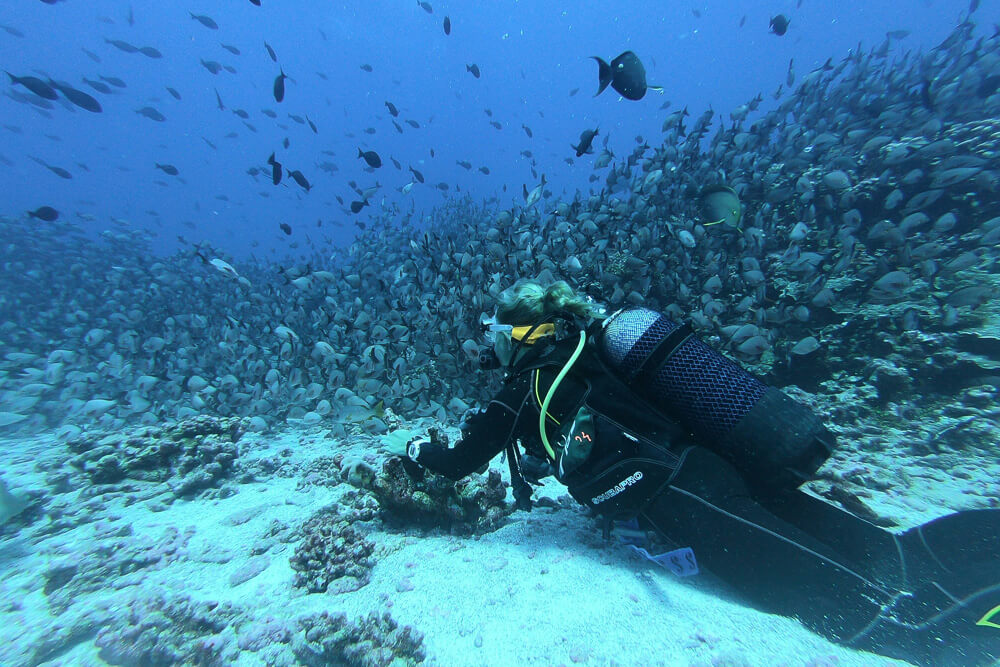
As one of the top scuba destinations in the world, the Rosario Islands outside of Cartagena are one of the best places to learn the sport or brush up on your skills. Even if scuba-diving isn’t your thing, the crystal-clear water and colorful coral reefs surrounding the islands are an extraordinary slice of paradise.
Part of the Parque Nacional Natural Corales del Rosario y San Bernardo, the islands are home to an abundance of diverse underwater species, from colorful coral to friendly fish. There are also a number of shipwrecks to explore, so if you’re into abandoned places, this might just be one of the most unique sites in the world to explore!
The Rosario Islands are located about 45 minutes by boat from Cartagena and can be visited independently or with a tour. To visit on your own, simply buy a boat ticket from el Muelle Turistico Bodeguita outside Cartagena’s Walled City. Tickets generally cost between 70,000-100,000 COP and leave around 8AM, though I recommend arriving early to secure your spot. Return trips usually leave between 3-4PM.
Another option is to join a private day tour. This day tour from Backpackers Cartagena includes snorkeling and lunch, so all you have to do is tag along for the ride! Alternatively, you could opt to stay a night or two on the island, especially if you want to try your hand at some scuba diving.
Looking for more of the best dive spots in Colombia? Check out my guide to the Island of San Andrés, which is home to the third largest coral reef in the world!
3. Visit the aviary on Isla Baru

As the country with the most bird species in the world, there’s no better place to explore the diversity of colorful species than at the National Bird Aviary. Located on Isla Barú an hour outside of Cartagena, the aviary can easily be combined with a beach day, though is easily worth a trip all on its own.
Home to over 170 species of birds, the National Bird Aviary houses birds from three different unique Colombian ecosystems – humid jungles, coastal regions, and dry deserts. Visits typically take around 2.5 hours as you wander through the three distinct regions and admire the colorful birds that call the aviary home.
The best part? The National Bird Aviary is a conservation effort dedicated to the preservation of a number of species, so a part of all ticket fees goes towards conservation. Tickets cost 70,000 COP ($18 USD) for foreign visitors and 45,000 COP ($11.50 USD) for Colombian nationals.
Recommended Reading: The Ultimate Guide to Providencia Island – Colombia’s Hidden Paradise
4. Fish with locals at La Boquilla
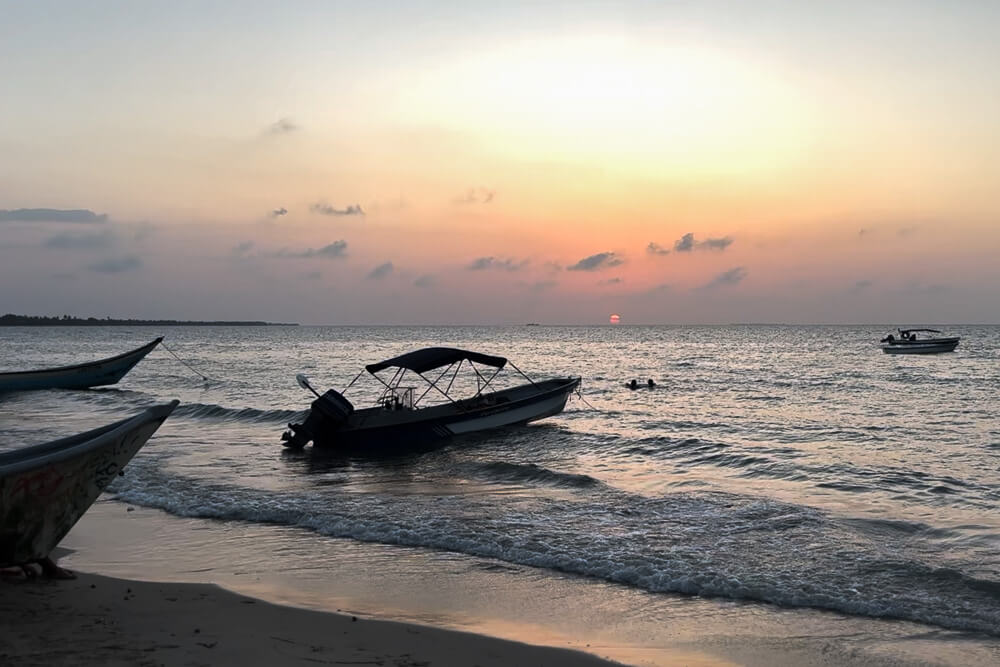
If you’re looking for some beach time with a more local feel than the tourist-heavy beaches of Isla Baru, look no further than La Boquilla. Located north of the city of Cartagena, this local fishing village is home to some of the most beautiful beaches in the area, spotted with fishermen casting their nets for the catch of the day. It’s one of the best day trips from Cartagena to get a true local beach feel.
With a long stretch of coastline, La Boquilla is the perfect place to lounge for a day. You can rent a bike to explore the sandy stretch, or even ride a horse along the shoreline. I recommend staying for the sunset if you are able – you can thank me later!
La Boquilla is also home to a number of mangroves, which create natural tunnels you can explore by boat. Home to Cienaga de la Virgin and Cienaga de Juan Polo, the coastal mangroves are one of the most unique ecosystems on the Colombian coast. Check out this tour of the mangroves, complete with demonstrations of traditional fishing methods, to learn more about how locals have lived in the area for centuries.
5. Learn the history of San Basilio de Palenque
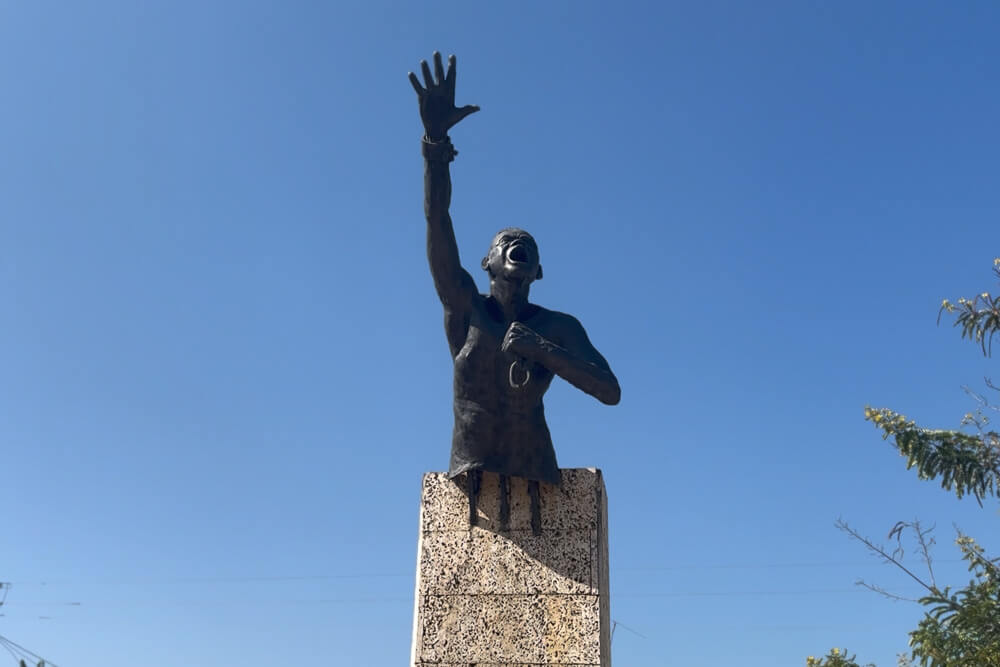
San Basilio de Palenque is one of the most extraordinary places I’ve ever visited – there’s a reason it’s my favorite thing I did in the department of Bolivar! Founded by African slaves, this town was the first freed town in the Americas, and has maintained much of the African traditions, music, medicine, and spirituality on which it was founded. In fact, you may hear it referred to as “The Africa of Colombia.”
San Basilio de Palenque is also the origin of the colorful Palenqueras, who you’ll see on nearly every street corner in the Walled City of Cartagena. In fact, the palenqueras historically walked the nearly 50 kilometers from Palenque to Cartagena to sell tropical fruit in the city in order to support their families. Palenqueras are just one of the extraordinary stories in Palenque.
San Basilio de Palenque is located about an hour from the Walled City, so it’s one of the best day trips from Cartagena. A guided tour is a must in order to gain a true understanding of the history and cultural significance of Palenque. There are plenty of English-speaking guided tours on GetYourGuide, though for Spanish-speakers, I highly recommend Benko Tours, run by my friend Neudis.
6. Chill out in the Totumo Mud Volcano
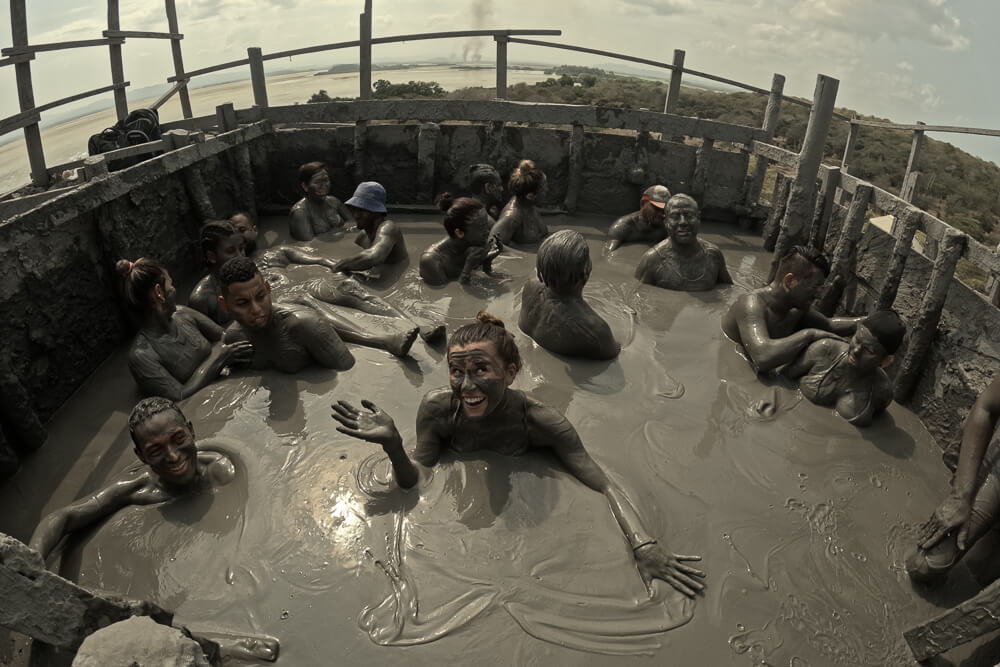
Perhaps the most unique day trip from Cartagena, the Totumo Mud Volcano is just that – a giant volcano filled with mud! Believed to have healing properties, visitors can take a soak in the mud bath at the top of the volcano before rinsing off in the nearby lagoon. If you’ve ever wanted to take a mud bath, now is your chance!
This site actually has an interesting history, as the mud bath is truly a former volcano. Now inactive, the mud is still enriched with volcanic minerals such as sulfur and silica, making it highly beneficial for your skin. For around 10,000 COP (~$2 USD) you can even pay an attendant in the volcano to give you a massage for the ultimate relaxing experience.
Located about an hour outside of Cartagena, it’s possible to visit Totumo Mud Volcano independently if you have your own transportation. However, a private taxi can be expensive, so if you’re traveling on your own, I recommend joining a guided tour like this one.
Entrance to the Totumo Mud Volcano as of 2024 is 25,000 COP (~$6 USD) per person. But make sure to carry a little extra cash if you want a massage, or maybe a hot cup of coffee after!
7. Admire the Pink Sea of Salinas de Galerazamba
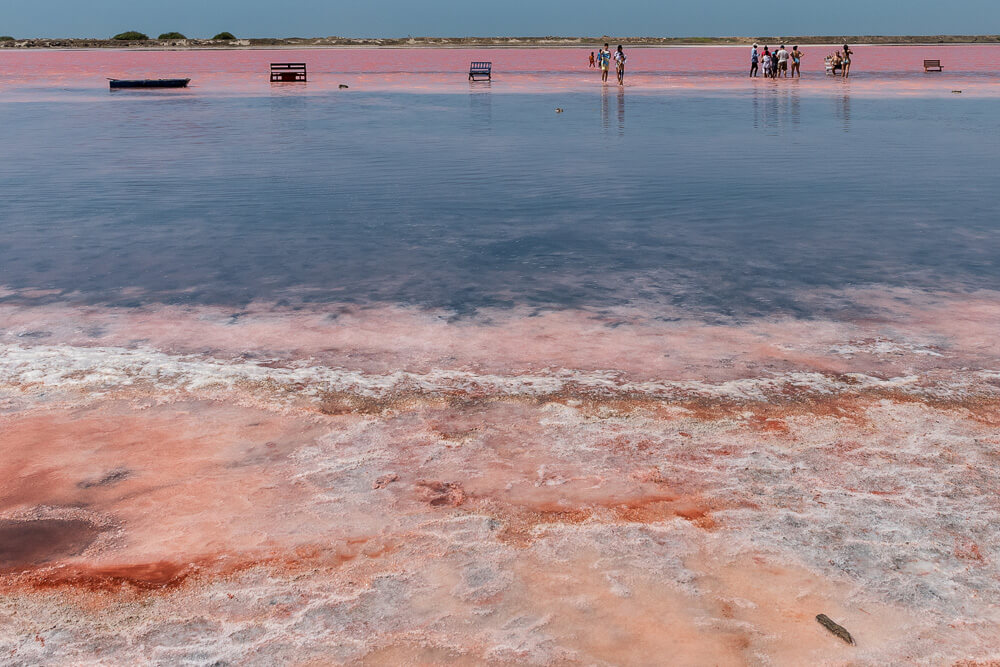
The Salinas de Galerazamba look like something out of a dream, the rosy pink sea dotted with birds and rimmed with powdery white salt. The sea actually gets its unique color from the high levels of salt in the water, which interact with rainfall and algae to create the unique pink color.
It’s important to note that the color of las salineras can appear more vibrant during certain times of year, specifically in January/February and August/September. The area itself is highly dependent on the weather, so you never quite know what
You can visit las salineras independently by taking a bus from Cartagena to Galerazamba from the Cartagena Terminal de Transportes. Another great option is to combine a visit to Galerazamba with a visit to the nearby Totumo Mud Volcano, check out this day trip that includes a stop at both!
8. Celebrate Semana Santa in El Carmen de Bolívar
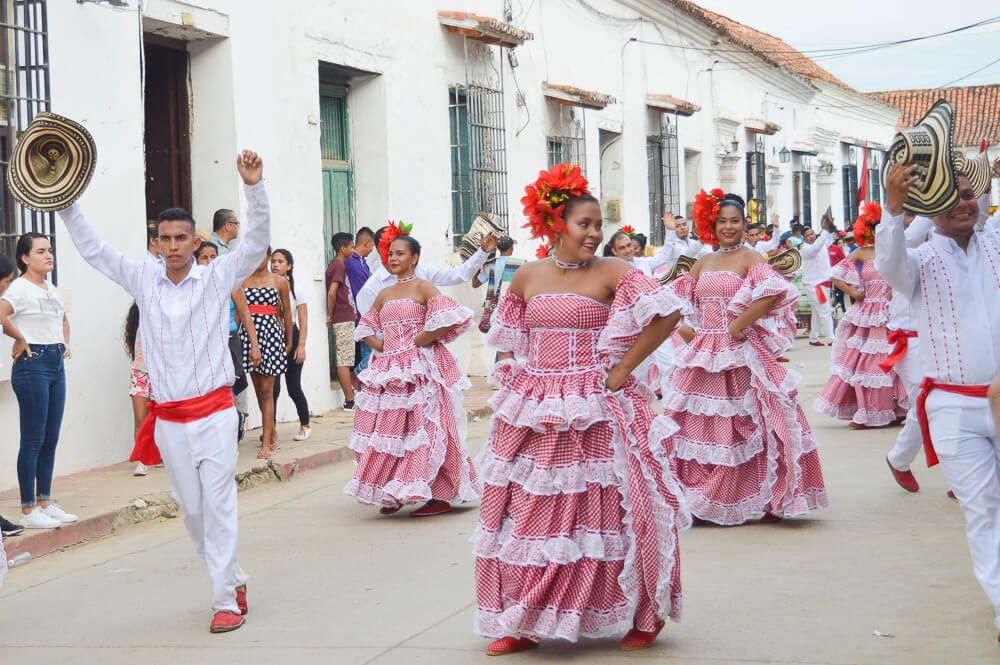
The town of El Carmen de Bolivar, or “The Sweet City,” isn’t just known for its production of typical coastal sweets. It’s also home to one of the largest Semana Santa celebrations in the country, with visitors traveling from all around Colombia to experience Holy Week in this colonial city.
If you happen to be visiting Cartagena during Holy Week, typically the last week or March or first week of April, a day trip to El Carmen de Bolivar is a great way to see a new side to this region. As an important religious holiday you’ll witness many parades and religious iconography, but the celebrations also include many elements of coastal Colombian culture.
The best way to visit El Carmen de Bolivar is by taking a bus from the Cartagena Terminal de Transportes. El Carmen de Bolivar is located about 2 hours from downtown Cartagena.
QUICK TIP: Keep an eye out for cumbia during the Semana Santa celebrations! This traditional dance has religious origins but is now a major piece of coastal Colombian culture. Want to learn more about cumbia? Check out my video about the dances and music of Barranquilla Carnival!
9. Wander the colonial streets of Mompox
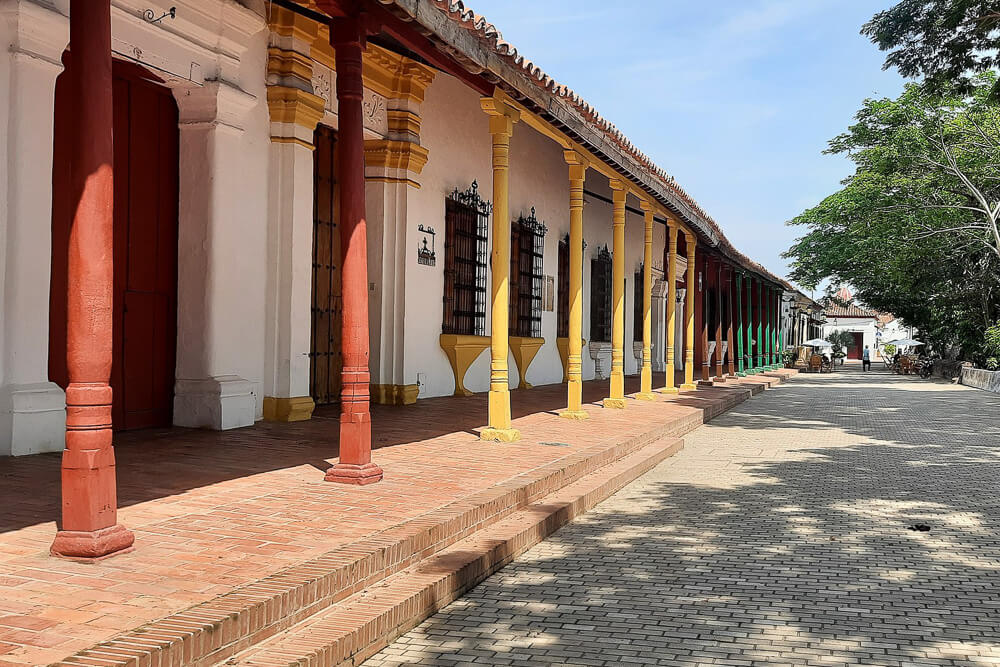
Considered one of the most beautiful towns in Colombia, Santa Cruz de Mompox (or simply Mompox) has wowed visitors for centuries. In fact, the colorful churches and colonial architecture are said to have inspired great Colombian author Gabriel Garcia Marquez himself.
Located about 5.5 hours from Cartagena, this town is possible as a day trip but truly deserves a night of its own if you have the time to spare. Located on the banks of the Rio Magdalena, it’s the perfect place to enjoy an evening stroll and watch the sunset over the number of historic churches in town.
Mompox is also known for its filigree, with some of the most talented goldsmiths in the country calling the town home. I highly recommend visiting a goldsmithing workshop while in town, or even picking up a bit of jewelry if you feel so inspired! Besides jewelry, the artisans in town are known for their intricate gold and silver religious art, which can be viewed at the Mompox Museum of Religious Art.
Mompox is great to visit year-round, but if you happen to be traveling during the springtime, it’s also known for its Holy Week celebrations. Mompox can be visited independently from the Cartagena Terminal de Transportes, or on a guided tour like this 2 day, 1 night trip from Cartagena.
10. Explore the shores of Parque Tayrona
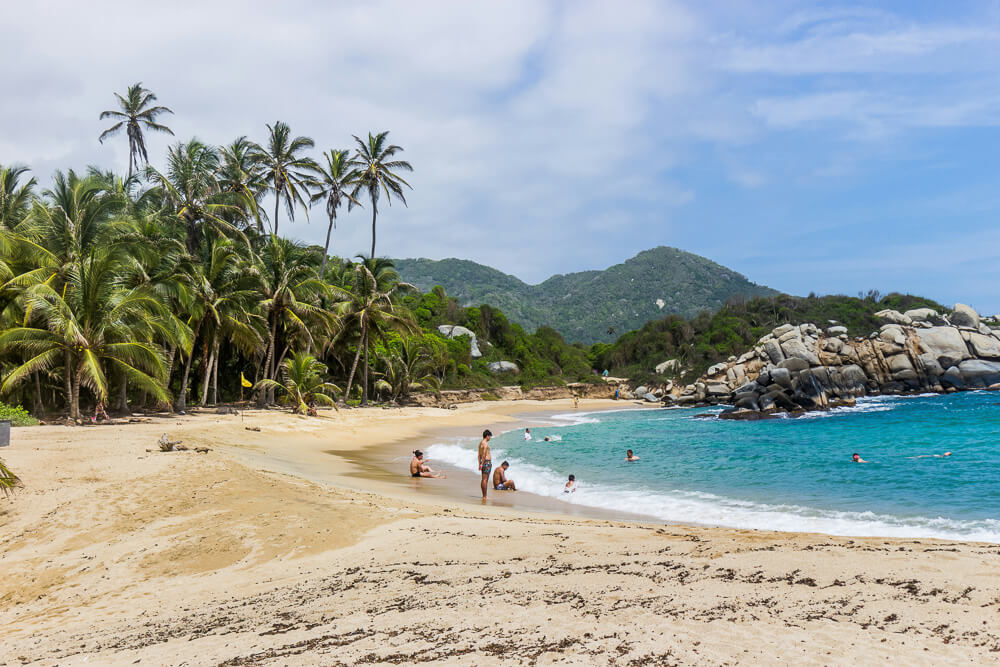
Here’s the thing — if you’ve got the time, Parque Tayrona is certainly worth it’s own multi-day trip. However, if you’re operating on a tight schedule, it can be visited as a day trip from Cartagena. I’d recommend going on a guided tour like this one so you’ll have direct transportation to the park and can optimize your time to see the most of it!
Named for the pre-Columbian Tayrona culture, Parque Tayrona is still a sacred site for the many indigenous groups that call the Sierra Nevada home. It’s also one of the most stunning shorelines in Colombia, from the popular Cabo San Juan to hidden pools along the shores. While there are certainly plenty of beautiful beaches near Cartagena, one could argue nothing quite compares to Tayrona.
It’s important to note that Tayrona National Park is generally closed annually the first two weeks of February to allow the local indigenous groups to cleanse and care for the area. This can vary year to year, so it’s best to check the Tayrona official website for the most up-to-date closings. Tayrona entrance fees cost COP 68,000 during high season (June-July and December-February) and COP 57,000 during low season.
Want to learn more about the Tayrona people? Consider a hike to La Ciudad Perdida, the ruins of an ancient city high in the mountains!
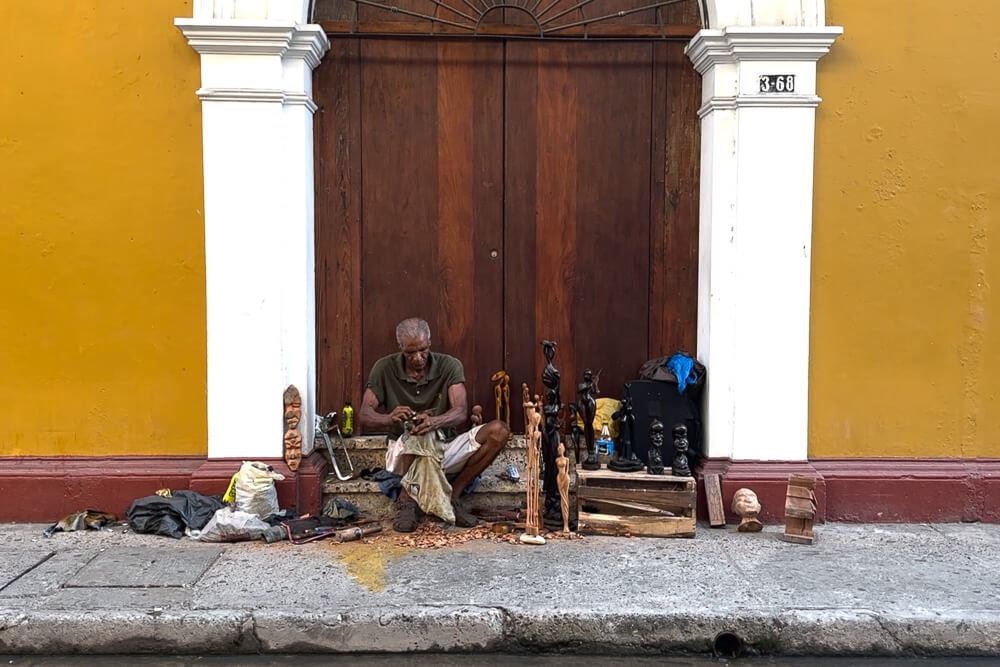
Keep Exploring Cartagena, Colombia
Cartagena is an extraordinary city to explore all on its own, from the colorful centro historico to the bustling city markets. It’s the most visited city in Colombia for a reason, drawing people from around the world with its powdery white beaches and diverse history. It’s also known for it’s celebrations, from it’s tropical Christmas festivities to it’s significant independence day.
However, the city is also a great base to explore more of the Colombian coast, from the rumba of Barranquilla to the mountainous coastlines of Santa Marta. Or if you’re looking to get a little off the tourist track, I highly recommend the southern coastal departments of Sucre and Córdoba.
In my journey to visit all 32 departments of Colombia, I’ve written extensively about many regions of the country, from the salsa capital of Cali to my home department of Quindío.
Did I miss any of your favorite day trips from Cartagena? Let me know in the comments!
Have limited time in Colombia? Check out my one-week itinerary to Colombia’s major cities!
What to Pack for Colombia
Planning a trip to Colombia? Consider adding some of these essentials to your suitcase for a truly epic trip!
💧 Filtered Water Bottle – Save on the single-use plastic and protect from parasites!
🧥 Heavy-Duty Rain Jacket – For the ever-changing Colombian weather!
🎒 Anti-theft Backpack – Perfect for exploring big cities or trekking in the jungle
🧖♀️ Microfiber Travel Towel – A go-to travel essential anywhere in the world!
🔌 Portable Charger – Keep your phone charged out on the go
🔐 Mini Padlock – Perfect for securing your backpack or locking up your items at the hotel
🔋 Universal Travel Adapter – Charge all your devices anywhere in the world!
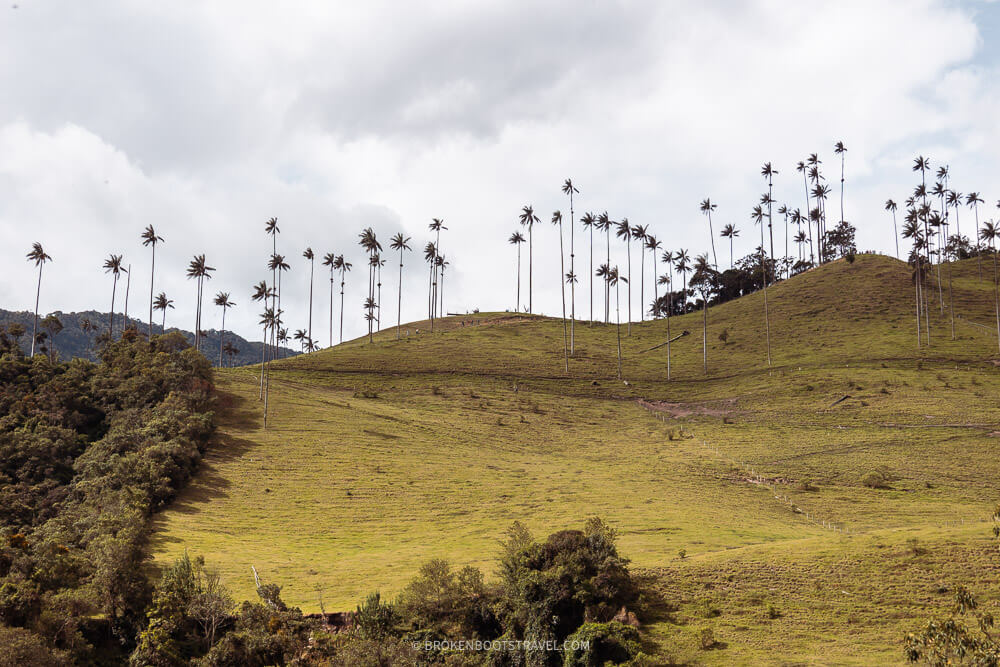



Love stories? Subscribe to my newsletter to get my latest updates delivered straight to your inbox every month. One email a month + no spam? Sign me up!
Virginia Taylor (Ginna) is a travel writer and photographer exploring the world until her boots wear through. She’s currently on a mission to explore all 32 departments of Colombia, though she formerly called the Middle East home. Want to know more? Visit the About Page.